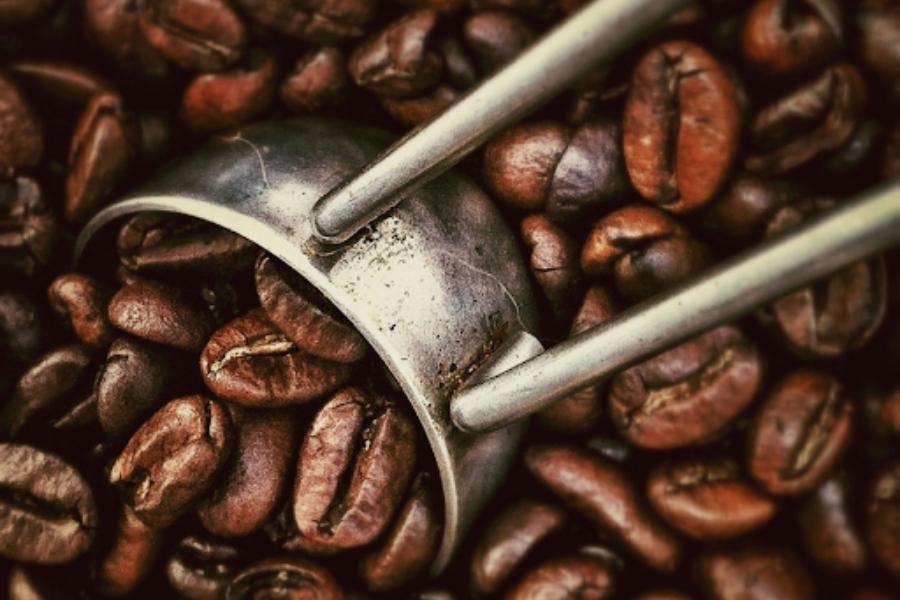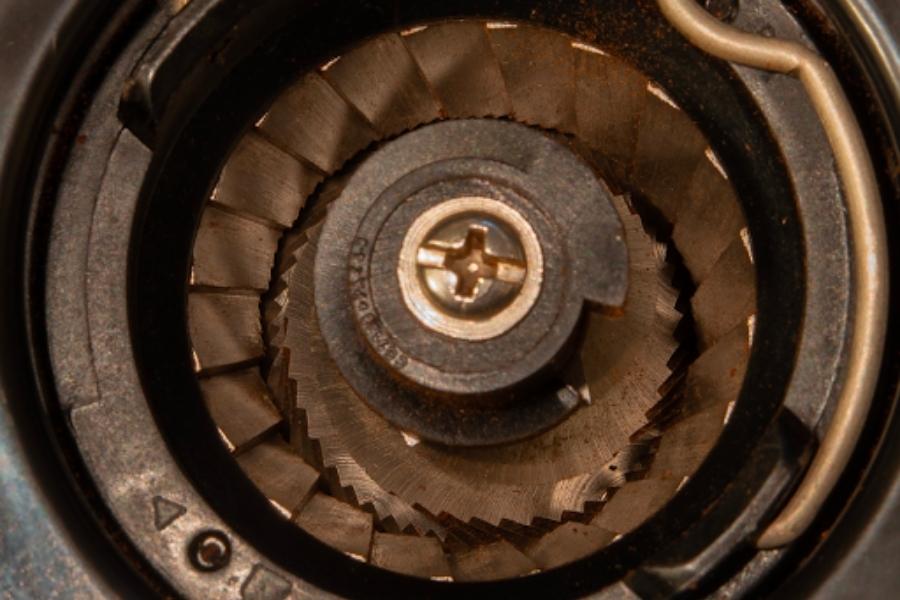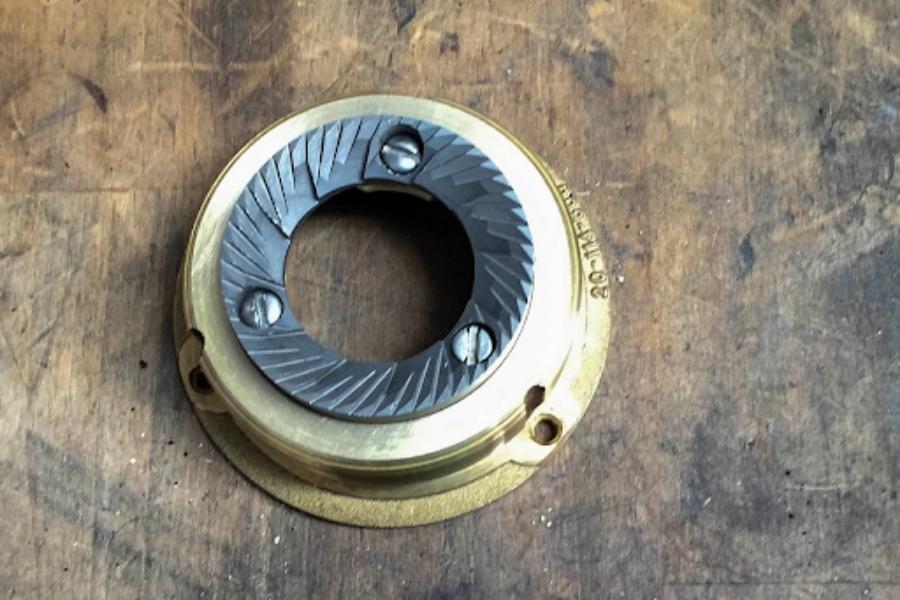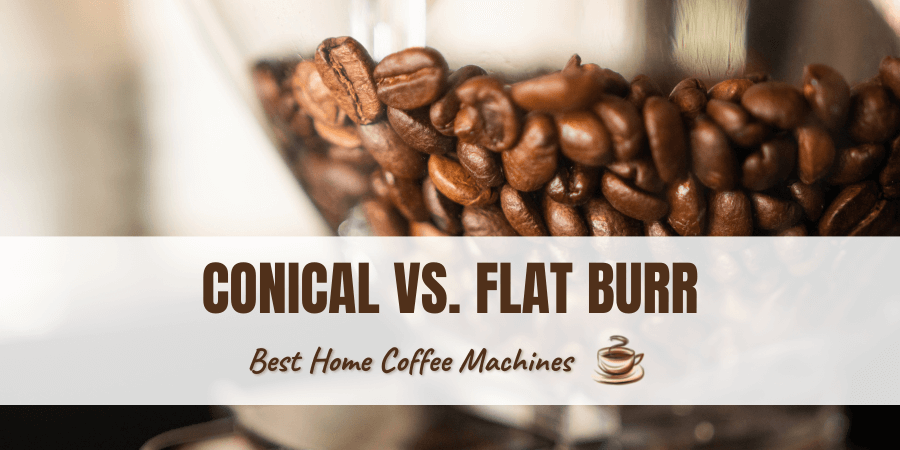Conical vs. Flat Burr
Any coffee connoisseur will tell you that Burr grinders are preferred for grinding coffee beans — they bring out the best in brewed coffee. However, things get a little more complicated when you look at conical vs. flat burr grinders.
What exactly is the difference between conical and flat burr grinders? While it’s unlikely that one will magically improve your cup of joe over the other, there are some differences between them.
From noise level to design type, let’s look at how a conical burr compares with a flat burr grinder. After examining both, you can decide which one is best for your kitchen. Some of the topics we’ll look at in this debate include:
What Is a Burr Grinder?
A burr grinder is a specific type of coffee grinder, where the beans are ground together between two plates. The beans repeatedly pass between the two surfaces. This differs from a blade grinder, which simply spins and chops coffee beans into smaller pieces.
If you would like to compare the two designs in more detail, we’ve weighed up the differences and similarities in this blade grinder vs. burr grinder guide.
The burr plates are made of either ceramic or stainless steel.
Ceramic is harder and remains sharper for longer, and it won’t rust, but it can also be more brittle. Stainless steel burrs are sharper initially, but this may dull over time. They also conduct heat during the grinding process, which may impact the coffee’s taste. And, stainless steel doesn’t trap the finely ground coffee like ceramic.
In addition, there are two shapes — flat burrs vs. conical burrs. To delve deeper into the realms of burr grinders, check out our complete 101 on the topic here.

Conical Grinder
With a conical burr grinder, one burr sits inside of another. The inner burr is — surprise! — cone-shaped with a larger base and spins. The outer burr is a hollow ring with angled teeth. Unlike the inside burr, the outer one is stationary.
Grinding happens vertically, and they feature channels that funnel coffee beans through the burrs. Gravity also makes this process a little easier, as beans move from the top of the burr to the bottom.
Advantages of Conical Grinders
So what makes conical burr grinders so great? There are several advantages to this type:
- Quieter operation. Gravity assists by forcing coffee beans to move down through the burrs. As a result, the grinder doesn’t need as much power. These grinders run at lower RPMs, hence the lower working volume.
- Kinder on the pocket. Conical burr grinders come at a much lower price tag than flat burr grinders. Most entry-level grinders are of this type.
- Less retention of fine grinds because of gravity. Beans move from top to bottom and are expelled at the bottom of the grinder. This also makes these grinders easier to clean.
- Calibration or alignment isn’t required. Providing they’re kept clean, there’s not much else involved.
Disadvantages of Conical Grinders
Despite the qualities of conical grinders, they do have a few disadvantages:
- Producing bimodal grinds. That is, rather than every grind being uniform, you’re left with two sizes — no matter what level of grind you’re trying to achieve. As a result, smaller grinds will extract more quickly than larger ones, resulting in flavor inconsistencies.
- While bimodal coffee grinds create java that has more texture, they can also give your brew a slightly sour taste.
- Slower grinding. Again, this is due to having less powerful motors. This difference isn’t significant for your average home barista, but it may matter to some.

Flat Grinder
While a conical grinder consists of one burr inside another, a flat burr grinder uses two rings that lie flat on each other, usually parallel. These rings also possess angled teeth, and one spins, while the other remains stationary.
Because these rings are horizontally aligned, coffee grinds are forced out through the sides rather than the top or bottom. It’s the distance between those two rings that determines the burr size. Flat burr grinders excel at grinding coffee beans for pour-over coffee and espresso. They’re mostly found in commercial espresso grinders, but if you’re willing to invest, you can buy them for your own kitchen.
Advantages of a Flat Grinder
There are several plus points to using a flat burr grinder:
- Consistent grinding — producing unimodal grinds — one size. This leads to an even and higher extraction percentage per grind — creating coffee with more clarity.
- Adjusting the grind size is straightforward.
- Offers you more control over brewing espresso, including the ability to pull a longer shot without over-extracting.
Disadvantages of a Flat Grinder
While many people prefer flat burr grinders, they also have some drawbacks:
- Retention of grinds is more common because of grounds being expelled through the sides, rather than up and down.
- Requires a higher RPM to grind beans. This creates more noise and may generate more heat than conical burrs. Flat grinders may have to be adjusted as a result of that heat. Aligning them properly can be tricky.
- Typically more expensive than conical burr grinders.

Which One Is Better?
So in the flat vs. conical burr grinder debate, is there a winner? In an ideal world where you don’t have to consider sticking to a budget, we’ll almost always go with a flat burr coffee grinder. Producing consistent grinds of the same size will always lead to a great cup of joe that’s perfectly extracted.
Flat burr grinders simply perform better overall, and this outweighs their higher price tag and noise levels.
Conclusion
The grinder of choice, both for quality and consistency, burr grinders are available with either ceramic or stainless steel, and conical or flat burrs.
Conical burrs grind coffee vertically, with one burr sitting inside a slightly larger one and spinning. They’re usually not as costly as their flat counterparts, and some prefer the bimodal grinding it produces, as it can add texture to java or espresso.
On the other hand, flat burrs result in unimodal grinding, with all coffee grounds being similar in size. Flat burrs are usually found in commercial grinders, which attests to their quality.
And, while we also favor a flat burr design, we appreciate that cost is often a significant factor. Even if your pocket can’t stretch to the flat burr, you’re still going to get a quality grind from conical burrs. With our comparison of conical vs. flat burr coffee grinders, you’ll know what to look for, no matter which one you prefer.
Conical vs. Flat Burr FAQs
Are Flat or Conical Burr Grinders Better?
For the best and most consistent grind, flat burr grinders are better than conical grinders. However, the latter is more expensive and requires more care and maintenance. Conical grinders are typically easier to clean.
Why Are Conical Burr Grinders Bimodal?
Because of the way that conical grinders operate, they produce grinds in two sizes. To the naked eye, it might not be noticeable, but flavors will be extracted from smaller grinds more quickly. This is why with conical vs. flat burr, taste may be affected.
How Does a Flat Burr Work?
Two flat burrs are paired next to each other and are aligned to be parallel. One spins, while the other burr remains stationary. Coffee beans are ground between the two, and then those grinds are expelled through the sides.
What Are Grinding Burrs Made of?
Usually, the grinding burrs are made of either ceramic or stainless steel. Ceramic burrs usually last longer than stainless steel, but may be prone to corrosion. Stainless steel burrs are sharper initially and often coated with another metal to make them rust-proof.
How Long Does a Burr Grinder Last?
As long as you take care of your burr grinder, you can expect it to last 5-10 years, depending on usage. If you use your grinder daily, it may be on the lower end of that range.
Is a Burr Grinder Really Worth It?
Absolutely! Burr grinders are largely preferred over blade grinders because of their quality and ability to produce super consistent grinds for coffee. Yes, they can be rather pricey, but you’ll enjoy better-tasting coffee for your money.





